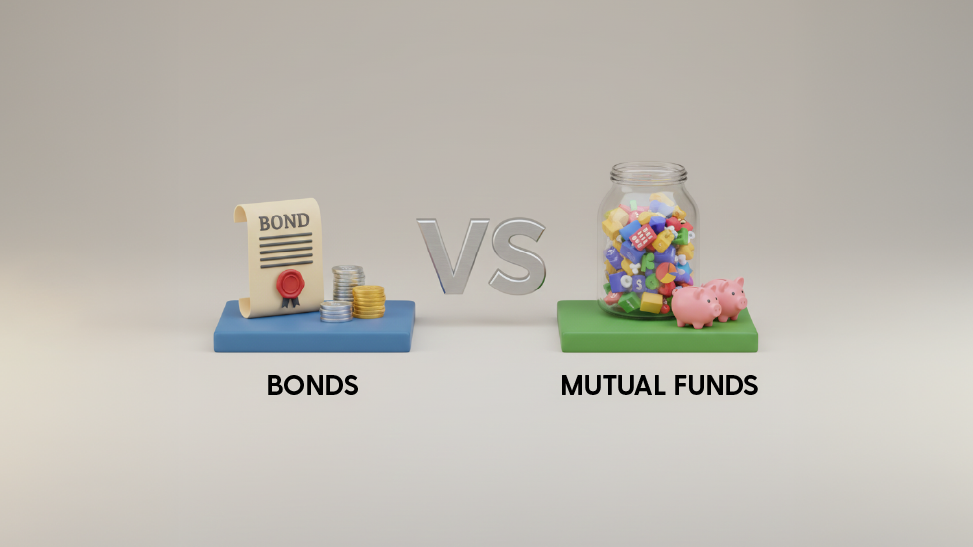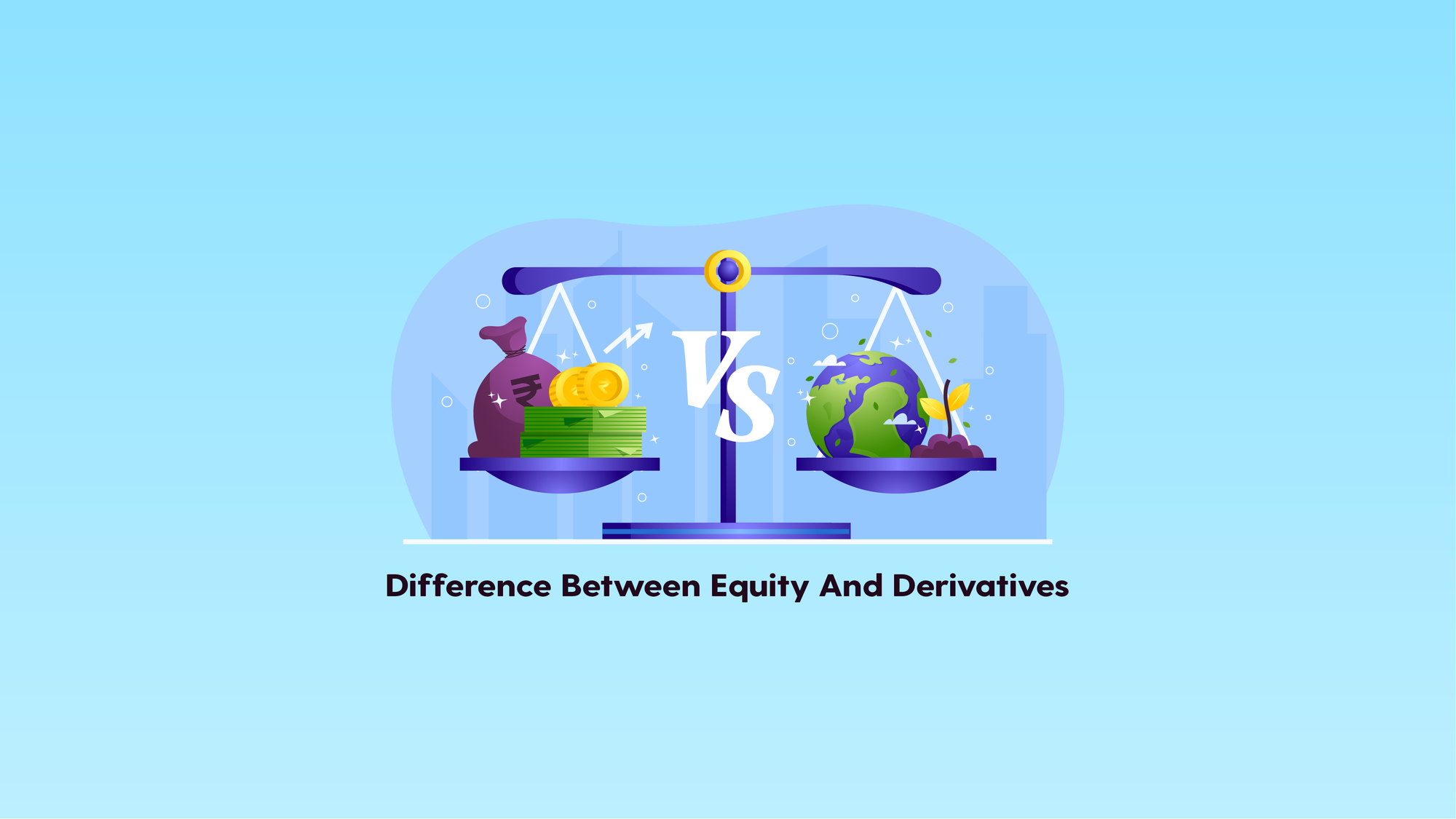- Home
- Blog
- Mutual Funds
- Bonds Vs Mutual Funds
- Bonds Vs Mutual Funds
Bonds Vs Mutual Funds

- Published Date: November 24, 2025
- Updated Date: November 24, 2025
- By Team Choice
If you are comparing bonds and mutual funds and wondering which is better for your financial goals, you’re not alone. Both are popular investment options in India, but they operate in different ways.
In this blog, we’ll delve into bonds vs mutual funds, exploring the key differences and understanding which option better aligns with your investment profile.
Before moving forward, let’s first understand what exactly bonds and mutual funds are:
What are Bonds?
Bonds are generally known as fixed-income instruments. By investing in bonds, you lend money to the government, public-sector companies, or private companies for a fixed period. In return for this investment, you will receive interest regularly and the principal amount at maturity. This investment option is considered more stable because returns are predictable.
In India, common types of bonds include: Government Securities (G-secs), Corporate Bonds, Sovereign Gold Bonds, RBI-Saving Bonds, etc.
What are Mutual Funds?
Mutual funds are considered an investment vehicle that pools money from different investors and invests that combined amount into a diversified portfolio of assets such as stocks, bonds, gold, or a mix of these assets. These funds are managed by professional fund managers appointed by Asset Management Companies (AMC) and regulated by SEBI.
Popular mutual fund categories in India include: Equity Funds, Debt Funds, Hybrid Funds, and Index Funds.
Bonds vs Mutual Funds: Key Distinctions Between Them
While both are investment options, their behaviour, risks, returns, and suitability differ significantly. Here are some of the key differences between bonds and mutual funds:
| Aspects | Bonds | Mutual Funds |
|---|---|---|
| Nature of Investment | Fixed-income instruments where you lend money to the issuer (Govt/Corporates). | Investment vehicles that pool money to invest in equity, debt, or a mix. |
| Management Approach | You retain full control over which bonds to buy, the purchase price, and when to sell. | Professionally managed by fund managers. |
| Risk Level | Generally low compared to other options, though the exact risk level varies based on the issuer’s credit rating. | Varies by type — equity funds are high-risk, debt funds are moderate, and hybrid funds are balanced. |
| Returns | Low risk providing moderate returns; often better than traditional FDs. | May deliver higher returns but carry greater risk due to market fluctuations and investment decisions. |
| Tax Rules |
Interests are taxed as per the Income Slab (Full Interest). STGC - Slab Rate (< 12 months). LTGC - 10% (Gains after 12 months) without indexation. |
Equity MFs: STCG at 20% and LTCG at 12.5% (on gains over ₹1.25 Lakh). Debt MFs purchased post-April 2023 taxed as per Income Slab Rate. |
| Liquidity | Limited liquidity since your money is typically returned only at maturity. | High liquidity; can usually be redeemed at any time unless a lock-in applies. |
| Suitability | Conservative investors seeking safety and stable income. | Investors with moderate to high risk tolerance seeking growth, diversification, and long-term wealth creation. |
| Charges | Minimal charges (mainly brokerage/platform fees). | Expense ratio and possible exit load apply. |
Which Option Fits Your Investment Profile?
Choosing between bonds and mutual funds depends on your financial goals, risk tolerance, and time horizon.
If you prefer stability and predictable returns with minimal risk, bonds are a better fit. But if you’re aiming for long-term growth and are comfortable with market ups and downs, mutual funds, especially equity or hybrid funds, may suit you more.
Many investors combine both to balance safety and growth within their portfolios.
Conclusion
The choice between bonds vs mutual funds depends on your goals, risk appetite, and investment horizon. Bonds provide stability and predictable returns, making them ideal for conservative investors or those nearing financial goals. Mutual funds, on the other hand, offer growth potential and diversification but come with higher market-linked risks.
The right choice depends on your financial objectives, risk appetite, and investment horizon. A thoughtful mix of both can help you manage risk while still working toward long-term wealth creation.
FAQs
1. Are bonds safer than mutual funds?
Yes, bonds, especially government bonds, are generally safer. Mutual funds carry market risk, especially equity funds. However, you should conduct your own research before investing.
2. Which gives higher returns, bonds or mutual funds?
Mutual funds, particularly equity funds, usually offer higher long-term returns than bonds. However, they also have a higher risk.
3. Can I invest in both?
Yes. Many investors use bonds for stability and mutual funds for growth to balance their portfolio.
4. How much should beginners invest?
Beginners can start with as low as ₹100 - ₹500 in mutual funds via SIPs. For bonds, the minimum investment varies but is often ₹1,000 or higher.
5. Are mutual funds more liquid compared to bonds?
Yes. Mutual funds (except ELSS) are generally more liquid than bonds, which may be harder to sell before maturity.
Recommended for you

Difference Between Equity and Derivatives

A Guide to Algo Trading: Strategies, Risks, and the SEBI Rules
Read this blog to know what is algo trading in stock market, it's benefits & why jiffy is best algorithmic trading platform in India.

FII DII Data - Live Data
